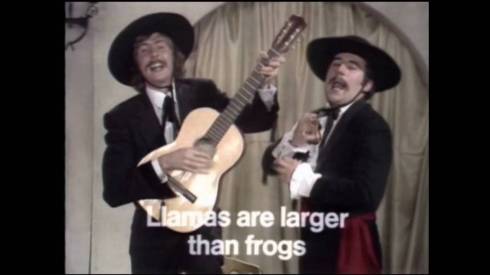My anthology of short, speculative fiction came out recently. I call it Strange Reports From Sector M. Customarily when a bestselling author releases a book, there’s a press tour, complete with personal interviews. Now this may come as a surprise to many of you, but I am not a bestselling author. Shocked face, right?
Since there aren’t a myriad of people busting my door down for an interview, I decided to do one on my own. The purpose of any one-on-one with the author is really just to let people know about the book, what’s it about, and why people should check it out. I’m going to do that for you here, right now. So, look at it as glimpse into my pet project, or a strange sort of FAQ. Either one is fine.
Alright, let’s get this show on the road!

Thanks for joining us here on Sector M, Matt.
Um, thanks? This is weird. I’m not the only who thinks so, right?
No idea what you mean. So, about your book. What is Sector M, exactly, and why are we getting strange reports from it, hmm?
Right, so Sector M has been my creative umbrella for a few years now. It covers all my social media, my books, even my wacky fanboy videos on Youtube. The name “Sector M” is a reference to my office, which at various times in the past has been called “The Museum of Matt” or “Sector Matt.” It’s my sanctum sanctorum. You know, just like Doctor Strange.
Okay, so Sector M is really just a proxy for saying “Matt Carson.”
In a way, yeah. I also set one of my earliest military sci-fi stories in a sector on the fringes of civilized space. The first surveyors had named all the star systems with words that began with the letter “M.” Thus, Sector M.
And is that story included in this anthology?
It is. It’s called “The Foeman’s Chain” and it’s the last one in the book.
What about the reports? Why are they strange? Do tell.
The stories in this book are pretty varied. Overall, it’s sci-fi, but there’s a bit of urban fantasy and horror mixed in as well. They all have some sort of anthropological or sociological theme to them. Humans are strange beings when you think about it. I’m perhaps a little stranger than most, so these resulting stories (or reports, if you will) are bound to be a bit ‘out there.’
Fascinating. Well now we need to take a quick break to learn an important fact about llamas!
Wait, what?

And we’re back!
What was that all about?
Just trying to break up the text with some graphics. Now, how is the book structured? Or is it all just sorta willy-nilly?
The stories get progressively longer from beginning to end. The first few stories are really short. The middle of the book has a few stories of a more “traditional” short-story length. At the end, I have two novellas or novelettes, depending on which definition you use. So, if you’re in the mood for something quick, look in the front. If you want something more substantial, go to the middle or back. You can read them in any order.
And how many stories are included, total?
There are 13 stories, all told. That seemed like a decent variety of different types of stories, lengths, and genres. Some are standalone stories, while a few others take place in a shared universe.
Do you have a favorite? I bet you do.
They all have a special place in my heart. No, I’m serious! I certainly don’t have an overall favorite among them, but I would say I’m particularly partial to “The Gossamer Thread” and “The Mundanity of Miracles.”
What are they about?
If you buy the book, you’ll find out. *wink*
Real subtle, Matt.
Just kidding. “Gossamer Thread” is about aliens who view us, the humans, as the ineffable ones. It also deals with society as a fragile construct, and trying to do what’s right when everything is falling down. “The Mundanity of Miracles” is about how the lines between reality and fiction are blurred in the future, and the problems that may come about as a result.
You mentioned societal themes before. Is there an overall theme for the book?
Interesting question. I wrote these stories without ever dreaming I’d assemble them together, so there’s no intentional theme to the book as a whole.
Wait, so you’re saying there’s an unintentional theme?
As I put it together, certain themes began to appear to me, like a Venn diagram overlapping at various points. But, much like when I see a cloud that looks like a duck, I may be seeing a pattern that isn’t really there.
See a lot of clouds shaped like ducks, do you?
Uh, sometimes, yeah.
Like this one?

Yeah. Just like that one. *mutters to himself.*
Well, what is this unintentional theme of which you speak?
No spoilers, for real this time. I’m going to leave that up to the reader to decide. I don’t want to bias opinions ahead of time. Come on, I have to leave at least a little mystery.
Isn’t that a bit of a cop out?
Maybe, but here we are.
Tool.
Oh yeah, and what does that say about you, then?
Good point. So shall we talk about the elephant in the room?
Sure…
Why is this book $12.99, huh? Who do you think you are, Dan Brown?
Not at all. This is a print-on-demand situation, which means the individual print costs for each book are higher than if it were a large print run. I realize I’m not an established “brand” when it comes to authors, but when all was said and done the minimum cost to print each book was over $12. For now, I like to think of it as 13 stories for 13 bucks.
Cute. Did you practice that little catchphrase?
Maybe a little, yeah.
What if that price point is just too much for people?
The Kindle version is also out. Since it’s just electrons, those minimum print costs are no longer an issue. With Kindle, readers can get the book for $5.99. That’s about one trip to Starbucks, and my book will last you a lot longer. *wink*
You’re winking again.
Oh, sorry…
If you’re gonna wink, at least take a lesson from the best.
And who’s that, pray tell?
So glad you asked…
Oh, here we go.

And, back. If we’re going with the “5 Ws and H” approach, what haven’t we answered yet?
Hmmm, let’s run them down:
Who: Me, Matt Carson.
What: A trade paperback book of short stories, all speculative fiction. Also on Kindle.
When: It’s out now! 🙂
Why: See below.
Where: Amazon and CreateSpace. Links below!
How: CreateSpace Author Services.
Ah, so it’s the Why that we need to talk about. So why did you decide to put this book together?
These stories are a part of me, and I wanted to share them. While I’m glad to have The Backwards Mask out there for folks to enjoy, I realize its length means that it’s quite an investment of time. So, for those who don’t have time for a 309,000-word novel, here are multiple stories you can read in a single sitting. There’s also something about holding a physical book in your hands that cannot be overstated. It’s the first time my fiction has appeared in print, so that’s exciting.
But why should the readers care about it?
I see what you did there. *approving nod*. This book really has a little something for everyone in the geekosphere. There’s plenty of action, but also introspection about our strange existence. I talk about war, cruelty, courage, and humanity’s unconquerable, if wildly contradictory, spirit. If you like any of the speculative fiction genres, there’s something here to scratch that particular itch. And if you like all of them, so much the better.
Anything you’d like to say to all the folks out there, then?
Yes, please support my work and consider picking up a copy. AND please leave a review on Amazon or Goodreads. Those are the two most important things you can do for any indie author—buy the book and leave a review.
In that case, where can we procure said anthology?
Right now, there are two places: Amazon and CreateSpace, directly. The text on this blog can sometimes obfuscate links (they don’t always stand out in blue), so please click on the word “here” in all three cases.
For Amazon, click here.
For CreateSpace, click here.
For the Kindle, click here.
Well, Matt, thanks for stopping by Sector M. We should do this again sometime.
What are you talking about? I’m here all the time on Sector M. I’m you.
But are you? Are you really?
Yes…?
Sorry, rhetorical question. So, that’s all the time we have. Check out Strange Reports From Sector M on Amazon and CreateSpace!
Until next time, see you around the Sector!


